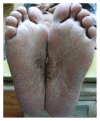Acrokeratosis Paraneoplastica Associated with Cervical Squamous Cell Carcinoma
- PMID: 28101384
- PMCID: PMC5215458
- DOI: 10.1155/2016/7137691
Acrokeratosis Paraneoplastica Associated with Cervical Squamous Cell Carcinoma
Abstract
Background. Acrokeratosis paraneoplastica, or Bazex syndrome, is a paraneoplastic syndrome characterized by cutaneous psoriasiform lesions with associated acral erythema and scale, as well as nail changes, including onycholysis and ungual dystrophy. Its most advanced, severe form involves the trunk, elbows, and knees. It is typically associated with upper aerodigestive tract malignancies in males. Rare cases associated with gynecological cancers have been reported, including uterine adenocarcinoma, as well as ovarian and vulvar squamous cell carcinomas. Cutaneous manifestations often precede cancer diagnosis. In most reported cases, skin changes resolve when the underlying malignancy is adequately treated. Main Observations. We present the case of a 56-year-old female diagnosed with acrokeratosis paraneoplastica following the discovery of FIGO stage IIB cervical squamous cell carcinoma (SCC). Scaling, hyperpigmentation, xerosis, and fissuring were noted on the patient's hands, feet, legs, arms, and lower back. Pitting was noted on her fingernails. Her cervical cancer was successfully treated with chemoradiotherapy, after which her cutaneous lesions persisted for two months before resolving. Conclusions. The presentation of acrokeratosis paraneoplastica in this context is atypical. Reports of associations with gynecological cancers, as in our patient's case, are exceedingly rare.
Conflict of interest statement
The authors have no conflict of interests to declare.
Figures



Similar articles
-
A Review of Nail Changes in Acrokeratosis Paraneoplastica (Bazex Syndrome).Skin Appendage Disord. 2021 Apr;7(3):163-172. doi: 10.1159/000513828. Epub 2021 Mar 2. Skin Appendage Disord. 2021. PMID: 34055903 Free PMC article. Review.
-
Bazex Syndrome Associated with Squamous Cell Carcinoma of the Lip: A Rare Paraneoplastic Acrokeratosis with Nail Dystrophy.Skin Appendage Disord. 2022 Jul;8(4):317-321. doi: 10.1159/000521269. Epub 2022 Jan 31. Skin Appendage Disord. 2022. PMID: 35983469 Free PMC article.
-
Acrokeratosis Paraneoplastica with Adenocarcinoma of the Colon Treated with Topical Tretinoin.Ann Dermatol. 2008 Dec;20(4):216-20. doi: 10.5021/ad.2008.20.4.216. Epub 2008 Dec 31. Ann Dermatol. 2008. PMID: 27303196 Free PMC article.
-
Acrokeratosis paraneoplastica Bazex syndrome associated with esophageal squamocellular carcinoma.Vojnosanit Pregl. 2008 Jun;65(6):485-7. doi: 10.2298/vsp0806485m. Vojnosanit Pregl. 2008. PMID: 18672707
-
Bazex syndrome (acrokeratosis paraneoplastica). An analytic review.Medicine (Baltimore). 1991 Jul;70(4):269-80. doi: 10.1097/00005792-199107000-00004. Medicine (Baltimore). 1991. PMID: 2067411 Review.
Cited by
-
A rare case of acrokeratosis paraneoplastica (Bazex syndrome) and a literature review.J Int Med Res. 2025 Feb;53(2):3000605251317998. doi: 10.1177/03000605251317998. J Int Med Res. 2025. PMID: 40012420 Free PMC article. Review.
-
[In search of the lost tumour].Aten Primaria. 2020 Mar;52(3):210-211. doi: 10.1016/j.aprim.2019.04.005. Epub 2019 May 23. Aten Primaria. 2020. PMID: 31130334 Free PMC article. Spanish. No abstract available.
-
A Review of Nail Changes in Acrokeratosis Paraneoplastica (Bazex Syndrome).Skin Appendage Disord. 2021 Apr;7(3):163-172. doi: 10.1159/000513828. Epub 2021 Mar 2. Skin Appendage Disord. 2021. PMID: 34055903 Free PMC article. Review.
-
Acrokeratosis neoplastica (Bazex syndrome): Report of two cases and literature review.Heliyon. 2024 Feb 22;10(5):e26411. doi: 10.1016/j.heliyon.2024.e26411. eCollection 2024 Mar 15. Heliyon. 2024. PMID: 38434419 Free PMC article.
-
Bazex Syndrome (Acrokeratosis Paraneoplastica): A Narrative Review of Pathogenesis, Clinical Manifestations, and Therapeutic Approaches.Cureus. 2023 Sep 16;15(9):e45368. doi: 10.7759/cureus.45368. eCollection 2023 Sep. Cureus. 2023. PMID: 37720135 Free PMC article. Review.
References
-
- Wu G. Y., Selsky N., Grant-Kels J. M. Atlas of Dermatological Manifestations of Gastrointestinal Disease. New York, NY, USA: Springer; 2013. - DOI
Publication types
LinkOut - more resources
Full Text Sources
Other Literature Sources
Research Materials

